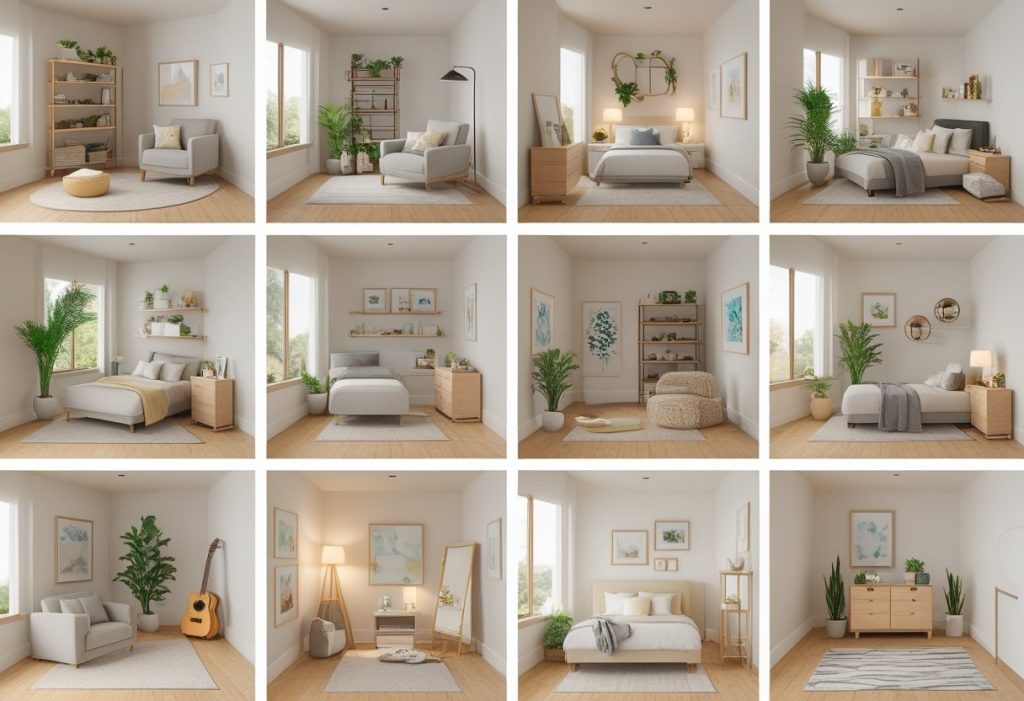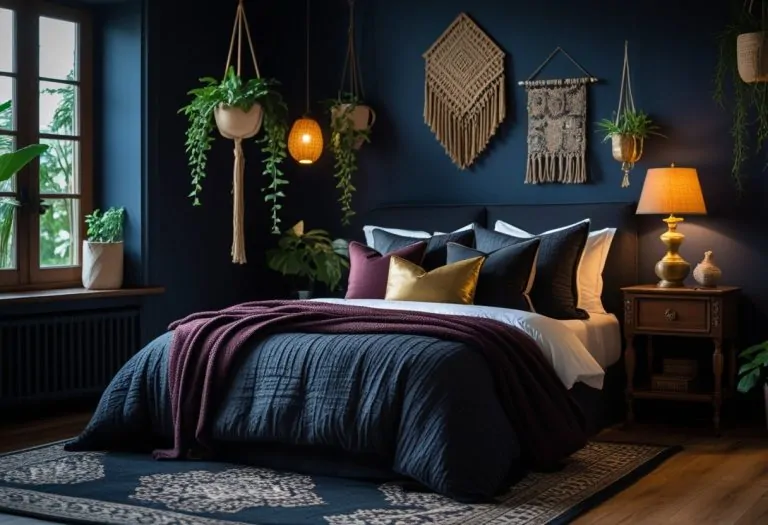15+ Smart Ideas to Style & Fill Empty Bedroom Corners
Empty bedroom corners often go unused, making a room feel incomplete or cluttered. Finding practical and stylish ways to fill these awkward spaces can improve both the function and aesthetic of a bedroom. Simple additions like corner desks, shelves, or cozy seating can transform these neglected areas into valuable parts of the room.

Many effective corner solutions do not require a complete redesign. Small furniture pieces, functional storage, or even decorative plants can add personality and purpose without overwhelming the space. These ideas help maximize every inch, especially in smaller bedrooms where every square foot matters.
By focusing on smart, easy-to-implement options, anyone can reimagine empty corners as attractive and useful. With the right choices, a challenging corner can become a focal point that balances beauty and utility.
Transform Empty Corners with Reading Nooks

Empty bedroom corners can become inviting spaces for relaxation and reading. Thoughtful design balances comfort with practicality, creating a dedicated spot for quiet moments. Incorporating lighting, seating, and storage solutions is key to a functional and appealing nook.
Cozy Reading Nook Setups
A cozy reading nook starts with comfortable seating. A cushioned chair or a built-in bench fitted with soft pillows and throws enhances comfort. Positioning the nook near natural light sources increases usability during the day.
Ambient lighting is essential for evening use. Task lamps, wall sconces, or string lights provide focused and gentle illumination without overpowering. Adding a small side table offers space for books, beverages, or reading glasses.
Soft rugs or floor cushions can ground the nook, adding warmth to hard floors. The choice of colors and textures should promote calmness, favoring muted tones and natural fabrics. This setup encourages longer, more enjoyable reading sessions.
Mini Library Creations
A mini library in a bedroom corner maximizes storage and display. Narrow, floor-to-ceiling shelves use vertical space efficiently. Adjustable shelving allows customization for different book sizes and additional decor items.
Incorporating closed cabinets at the bottom keeps clutter hidden and organized. Using open shelves above encourages easy access to favorite titles. Labeling or categorizing books by genre or color can enhance visual appeal.
Including a small seat or stool adjacent to the shelves adds convenience. Combining storage with a reading space creates a seamless transition between choosing a book and settling in to read. This approach optimizes unused corners without crowding the room.
Display and Decorate with Stylish Solutions

Empty bedroom corners offer excellent opportunities to introduce visual interest and personalized style. Choosing the right approach can enhance the room’s character while maintaining function.
Art Display Gallery
Using a dedicated art display in a corner elevates the aesthetic focus of the bedroom. Shelves or floating ledges can hold sculptures, framed photos, or small canvases, creating a mini gallery without overwhelming the space.
Proper lighting is essential. Adjustable spotlights or LED strips highlight the pieces and add depth. The display should complement the room’s color scheme and avoid overcrowding, maintaining a clean and intentional look.
Art pieces in varied sizes and textures bring contrast and dimension. Arranging objects with different heights adds visual rhythm, turning an overlooked corner into a curated art nook.
Showcasing with Gallery Walls
Gallery walls allow multiple artworks or framed objects to transform a corner wall into a feature. Grouping prints, photos, or paintings in coordinated frames creates cohesion and structure.
Layout planning is crucial. The grid method, salon style, or linear arrangement can be used to balance the corner wall’s shape. Frames aligned with furniture edges or architectural lines ensure integration with the room’s design.
Mixing mediums—art, mirrors, or wall-mounted decorations—adds interest. Keeping color palettes consistent across the pieces helps unify the display, preventing visual clutter.
Statement Room Dividers
A room divider positioned in a bedroom corner can define space and add texture or color contrast. It serves both as a decorative element and practical solution for creating separate zones.
Materials such as wood, metal, or fabric screens offer different aesthetics. Tall, freestanding dividers provide privacy and can double as wall art or shelving if designed with multifunctionality.
Choosing dividers with intricate patterns or bold colors draws attention and anchors the corner visually. It’s important the divider complements rather than overwhelms the existing decor and fits the corner’s dimensions precisely.
Maximize Storage and Functionality

Empty bedroom corners offer prime opportunities to add extra storage while maintaining a clean, organized look. Smart furniture choices can increase usable space without crowding the room. Small additions like shelves and multi-purpose tables make everyday items accessible and keep clutter minimal.
Floating Shelves for Storage
Floating shelves are effective for utilizing vertical space in bedroom corners. They provide easy access to books, decor, and essentials without taking up floor space. Because they mount directly to the wall, they keep the area open and visually light.
Installing multiple tiers of floating shelves can create a layered look, increasing storage capacity. Using uniform materials and colors ensures the shelves blend seamlessly with the room’s design. They also allow personalization with items that fit the occupant’s needs, from plants to bedside reading materials.
Nightstand Alternatives
Traditional nightstands can sometimes overwhelm small corners. Alternatives like narrow shelving units or compact carts provide similar functionality in a smaller footprint. These options often have open shelving for quick storage or drawers to conceal clutter.
Choosing a nightstand alternative that fits the available corner space prevents overcrowding while keeping lamps, phones, or alarm clocks within easy reach. Some models come with wheels, improving flexibility to move furniture when needed.
Multi-Purpose Side Tables
Side tables designed for more than one function are ideal for optimizing bedroom corners. Tables with built-in drawers or storage compartments add hidden space for personal items, reducing visible clutter.
They can serve as a nightstand, extra surface, or even a small desk. Materials vary from wood to metal, allowing integration with various design styles. Selecting a multi-purpose side table with a compact profile ensures the corner remains accessible and usable.
Create Inviting Seating Spaces

Empty bedroom corners can become practical and attractive seating areas. Choosing the right furniture and layout is key to creating a spot for relaxation or reading without overcrowding the room.
Accent Chair Corners
An accent chair in a bedroom corner adds both function and style. Select a chair with comfortable padding and a design that complements the room’s color palette.
Placing the chair near a window enhances natural light, making the space more inviting. The chair acts as a focal point and provides a dedicated spot for reading or unwinding.
Consider pairing the chair with a small throw pillow or blanket for added comfort. This setup turns a neglected corner into a purposeful part of the bedroom.
Adding a Cozy Chair and Table Combo
Combining a cozy chair with a side table creates a balanced and useful corner. The side table holds essentials like books, a lamp, or a cup of tea, offering convenience near the seating area.
Choose a table with a slim profile to avoid overwhelming the space. Materials like wood or metal can be matched with the chair’s style for visual cohesion.
This pairing encourages spending time in the corner for quiet moments or preparing for the day. Proper arrangement maximizes comfort without cluttering the bedroom.
Bring Life with Plants and Greenery

Adding plants to bedroom corners introduces texture and color while improving air quality. Thoughtful placement helps maximize their visual impact and integrates greenery naturally into the space.
Arranging Indoor Plants
Selecting a mix of plant sizes creates visual interest. Larger plants like snake plants (Sansevierias) or dracaenas anchor corners, providing height and structure. Smaller pots with species such as pothos or ferns offer variety and fill lower gaps.
Grouping plants with similar care requirements simplifies maintenance. Use well-draining pots and coordinate containers for a cohesive look. Position plants to receive suitable light—bright indirect for most, low light for shade-tolerant varieties—to keep them healthy.
Layering Tall and Hanging Plants
Layering plants vertically optimizes corner space. Tall plants in floor pots provide a strong base, while hanging planters add dimension and soft edges.
Hanging vines like philodendrons or string of pearls create movement and draw the eye upward. Combining these with tall, upright plants balances height differences and fills awkward spaces without clutter.
Using shelves or wall hooks can enhance layering. This approach promotes an inviting atmosphere, allowing the corner to feel lush without overwhelming the room.
Unique & Practical Bedroom Corner Ideas

Empty bedroom corners can serve both decorative and functional purposes when approached thoughtfully. Options like display cabinets enhance storage and style, while room dividers define spaces without sacrificing openness. Organizational tools tailored to corner layouts also maximize utility without cluttering the room.
Use of Display Cabinets
Display cabinets transform unused corners into focal points by combining storage with aesthetic appeal. Tall or corner-shaped cabinets fit snugly, allowing for the display of decor items, books, or collectibles while keeping the area tidy.
Glass doors or open shelving highlight decorations or prized possessions, adding personality to the room. Cabinets with closed sections provide concealed storage, ideal for minimizing visible clutter.
Materials like wood or metal can complement various bedroom styles. Lighting inside the cabinet enhances visibility and atmosphere. Choosing a cabinet with a narrow footprint prevents overcrowding in smaller spaces, making the corner more inviting and practical.
Incorporating Room Dividers for Function
Room dividers in bedroom corners serve multiple functions beyond separating spaces. They help create a private nook or visually separate a sleeping area from a workspace or dressing zone.
Options include folding screens, shelving units, or modular panels. These pieces can add texture, color, or storage without building permanent walls. Shelving dividers blend function with openness, allowing light and air to circulate while defining the area.
Choosing a divider that fits the corner angle ensures it does not overwhelm the room’s layout. Mobile or lightweight dividers offer flexibility in changing the room’s configuration as needed.
Creative Organizational Solutions
Organizational tools in corners make the most of limited space by targeting vertical and awkward areas. Wall-mounted shelves, hanging racks, or corner desks efficiently utilize the space without encroaching on the floor area.
Using baskets, labeled bins, or drawer units within these setups keeps everyday items orderly. Combining storage and display in open shelves balances utility with style.
Integrating more than one element, like a small desk with shelving above, creates multifunctional corners. Thoughtful placement avoids overcrowding and maintains clear pathways in the bedroom, improving flow and accessibility.







